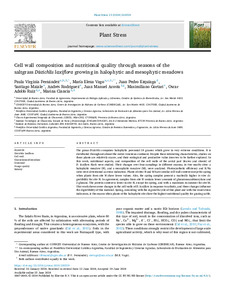Please use this identifier to cite or link to this item:
https://repositorio.uca.edu.ar/handle/123456789/18360| Título: | Cell wall composition and nutritional quality through seasons of the saltgrass Distichlis laxiflora growing in halophytic and mesophytic meadows | Autor: | Fernandez, Paula Virginia Vago, María Elena Ezquiaga, Juan Pedro Maiale, Santiago Rodriguez, Andrés Acosta, Juan Manuel Gortari, Maximiliano Ruiz, Oscar Adolfo Ciancia, Marina |
Palabras clave: | DISTICHLIS LAXIFLORA; PARED CELULAR; GLUCURONOARABINOXILANOS; PASTIZALES; CALIDAD DEL FORRAJE; SALINIDAD; GANADO | Fecha de publicación: | 2024 | Editorial: | Elsevier | Cita: | Fernandez, P. V. et al. Cell wall composition and nutritional quality through seasons of the saltgrass Distichlis laxiflora growing in halophytic and mesophytic meadows [en linea]. Plant Stress. 2024 (13)100519. doi: 10.1016/j.stress.2024.100519. Disponible en: https://repositorio.uca.edu.ar/handle/123456789/18360 | Resumen: | Abstract: The genus Distichlis comprises halophytic perennial C4 grasses which grow in very extreme conditions. It is distributed throughout almost the entire American continent. Despite these interesting characteristics, studies on these plants are relatively scarce, and their ecological and productive value deserves to be further explored. In this work, nutritional aspects, and composition of the cell walls of the aerial part (leaves and shoots) of D. laxiflora Hack were studied. Their changes over four samplings in different seasons, in two nearby sites: a halophytic meadow (H), and a mesophytic meadow (M), were analyzed. Photosynthetic efficiency and K/Na ratio were determined as stress indicators. Plants of sites H and M have similar cell wall content except for spring when plants from site H show lower values. Also, the spring samples present a markedly higher in vitro digestibility for site H. In agreement, samples from site H contain lower amounts of glucuronoarabinoxylans and β-glucans. The protein content is lower in site H, except for spring, and with a maximum in summer for site M. This work shows some changes in the cell walls of D. laxiflora in response to salinity, and these changes influence the digestibility of this material. Spring, coinciding with the regrowth cycle of this plant and with the worst stress indicators, is the season when plants of the halophytic site show the highest nutritional quality for grazing cattle. | URI: | https://repositorio.uca.edu.ar/handle/123456789/18360 | ISSN: | 2667-064X (online) | Disciplina: | MEDICINA | DOI: | 10.1016/j.stress.2024.100519 | Derechos: | Acceso abierto | Fuente: | Plant Stress. 2024 (13)100519 |
| Appears in Collections: | Artículos |
Files in This Item:
| File | Description | Size | Format | Existent users please Login |
|---|---|---|---|---|
| cell-wall-composition.pdf | 5,48 MB | Adobe PDF |  Request a copy |
This item is licensed under a Creative Commons License

